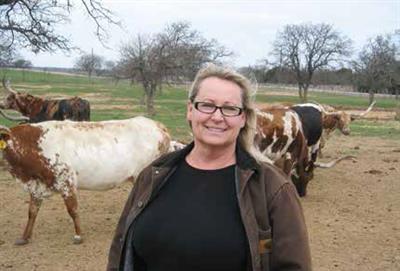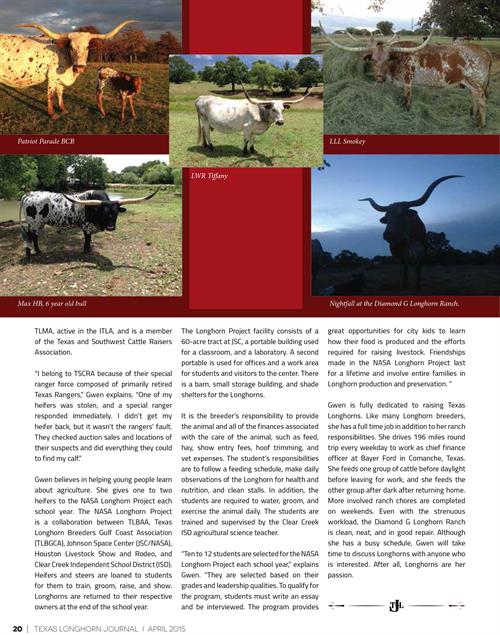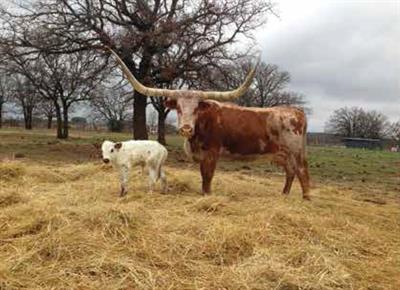by
Laura Huff
| Jan 05, 2016
The April 2015 issue of the Texas Longhorn Journal featured our customer Gwen Damato, of Diamond G Ranch. While her initial interest in the breed was financial, her Texas Longhorns have become a huge part of her life. She works hard to connect with others in the industry by participating a handful of organizations and helps to spark future interest by donating calves to an educational project. Be sure to check out the program she has built at Diamond G Ranch, just visit her Hired Hand website.
www.diamondglonghorns.com
Gwen Damato: Keeping the Texas Heritage Alive
By Robert Fears
 Gwen Damato of Diamond G Ranch.
Gwen Damato of Diamond G Ranch.
It took Gwen Damato a while to find Texas. She was born in Chicago, lived in Michigan, migrated to New York, moved across the nation to California, made a second U-turn at Los Angeles, and headed straight for Texas, never looking back.
Her love for animals accelerated at age 12 when, upon returning home from summer camp, her parents surprised her with a Paint horse. Gwen developed a passion for Paints, which led her into the horse business. She raised Paints but also began rescuing race horses from the tracks in California.
When land values began to soar in the Weatherford, Texas area and Gwen’s real estate taxes increased sharply, she had to find another enterprise that would qualify for an agricultural land evaluation. She learned that it is extremely hard to qualify for the lower tax basis with horses, so Gwen began researching other animal enterprise opportunities.
“I became amazed over the amount of good information that can be found on the web,” Gwen said. “When I began reading about Texas Longhorn cattle, I immediately knew I wanted to raise them. They are Texas heritage, and the breed needs to be preserved.”
Gwen’s deep love for Texas Longhorns and her strong belief that Texas heritage needs to be kept alive qualify her as a true Texan. Her Longhorn business has outgrown the small place she originally purchased, and even with leased pasture from a neighbor, she needs more land. She is in the process of buying a bigger ranch in the area and will be moving her operation in the near future.
Management Practices
After thorough study of Longhorn pedigrees and genetics, Gwen knows the traits she
wants in her cattle. She breeds for good milk production, calving ease, large bodies with good conformation, docile temperament, horns with a twist, and flashy coloring. For herd sires, Gwen likes the WS Jamakizm bloodline, and for dams, she likes ECR Eternal Tari and Shadow Jubilee genetics.
Gwen firmly believes that uniqueness of the breed should not be lost in the quest for the longest horns. She believes with strong conviction that the breed should be kept pure and registration requirements should be tightened.
“I work my cattle in the spring and have a veterinarian vaccinate for brucellosis, the clostridia complex and respiratory diseases,” Gwen says. “We administer a wormer, palpate the cows, and brand the calves. I move and work the cattle on foot in a slow, easy manner. You have to give Longhorns time to work their horns through gates and down the chute. They know how to do it, but they move slowly.
“The cows are exposed to the bulls in May. I first put the embryo transfer, three-year-old bull, Cool Texa, with them and then use my older bull, Max HB, to breed the cows that the younger one misses. My calves are born in February usually in two groups about two weeks apart. Near calving time, I move the cows to the pasture around the house, so that they can be watched more closely, although Longhorns very rarely have calving problems.”
Gwen adds, “My calving problems stem from coyotes. I spent most of the last two nights sitting in a tree house, left by the previous owner of the ranch, running off coyotes with my spot light. They were trying to get to a new-born calf.”
Gwen practices rotational grazing and supplements with hay and protein cubes. Calves are fenceline weaned. The concept of fenceline weaning is leaving calves and cows in pastures with just a fence between them. This weaning method reduces stress on both the dam and the calf, because they can see each other at all times. Within a few days to a week, they move away from the fence and go their separate ways.

Giving to the Industry
“I believe in working in unity toward common goals,” says Gwen. “It would be nice if the three Longhorn organizations would work together as one force. We could do so much more for the industry as a united front than what we can accomplish separately.”
Gwen is Director of Division B, Region 8 of the TLBAA. She is a Founding Member of the TLMA, active in the ITLA, and is a member of the Texas and Southwest Cattle Raisers Association.
“I belong to TSCRA because of their special ranger force composed of primarily retired Texas Rangers,” Gwen explains. “One of my heifers was stolen, and a special ranger responded immediately. I didn’t get my heifer back, but it wasn’t the rangers’ fault. They checked auction sales and locations of their suspects and did everything they could to find my calf.”
Gwen believes in helping young people learn about agriculture. She gives one to two heifers to the NASA Longhorn Project each school year. The NASA Longhorn Project is a collaboration between TLBAA, Texas Longhorn Breeders Gulf Coast Association (TLBGCA), Johnson Space Center (JSC/NASA), Houston Livestock Show and Rodeo, and Clear Creek Independent School District (ISD). Heifers and steers are loaned to students for them to train, groom, raise, and show. Longhorns are returned to their respective owners at the end of the school year.
The Longhorn Project facility consists of a 60-acre tract at JSC, a portable building used for a classroom, and a laboratory. A second portable is used for offices and a work area for students and visitors to the center. There is a barn, small storage building, and shade shelters for the Longhorns.
It is the breeder’s responsibility to provide the animal and all of the finances associated with the care of the animal, such as feed, hay, show entry fees, hoof trimming, and vet expenses. The student’s responsibilities are to follow a feeding schedule, make daily observations of the Longhorn for health and nutrition, and clean stalls. In addition, the students are required to water, groom, and exercise the animal daily. The students are trained and supervised by the Clear Creek ISD agricultural science teacher.
“Ten to 12 students are selected for the NASA Longhorn Project each school year,” explains Gwen. “They are selected based on their grades and leadership qualities. To qualify for the program, students must write an essay and be interviewed. The program provides great opportunities for city kids to learn how their food is produced and the efforts required for raising livestock. Friendships
made in the NASA Longhorn Project last for a lifetime and involve entire families in Longhorn production and preservation. ”
Gwen is fully dedicated to raising Texas Longhorns. Like many Longhorn breeders,
she has a full time job in addition to her ranch responsibilities. She drives 196 miles round trip every weekday to work as chief finance officer at Bayer Ford in Comanche, Texas. She feeds one group of cattle before daylight before leaving for work, and she feeds the other group after dark after returning home. More involved ranch chores are completed on weekends. Even with the strenuous workload, the Diamond G Longhorn Ranch is clean, neat, and in good repair. Although she has a busy schedule, Gwen will take time to discuss Longhorns with anyone who is interested. After all, Longhorns are her passion.

HL Bright Star with her heifer calf from Cool Texa.
Posted with Permission from the Texas Longhorn Journal.
www.thelonghornalliance.com
www.facebook.com/TheTexasLonghornJournal/